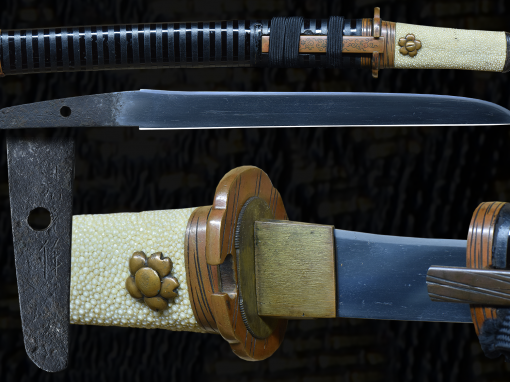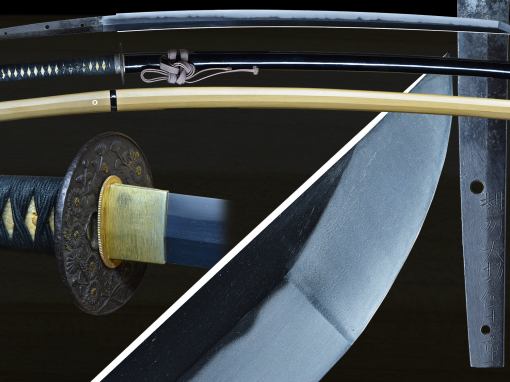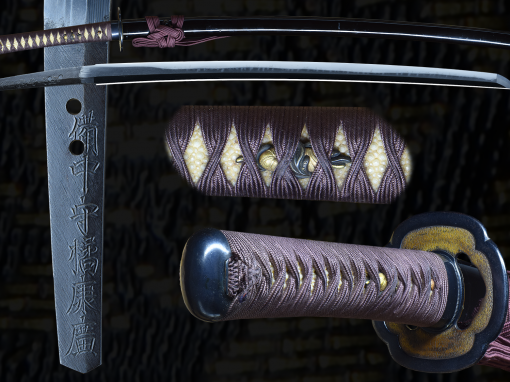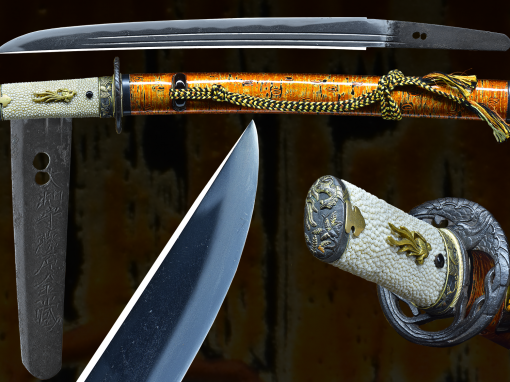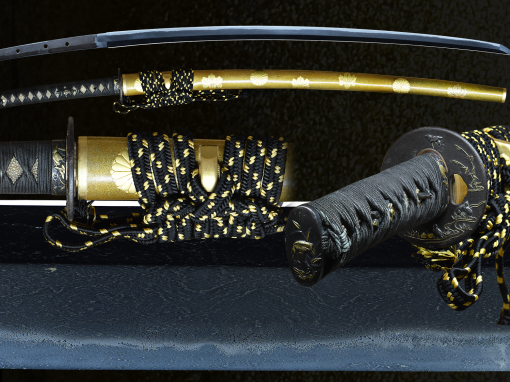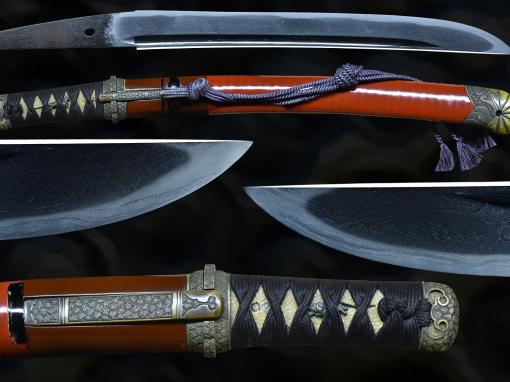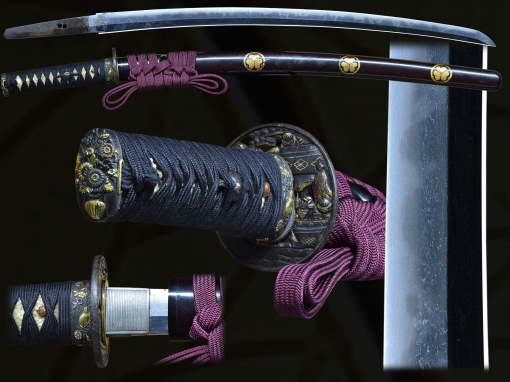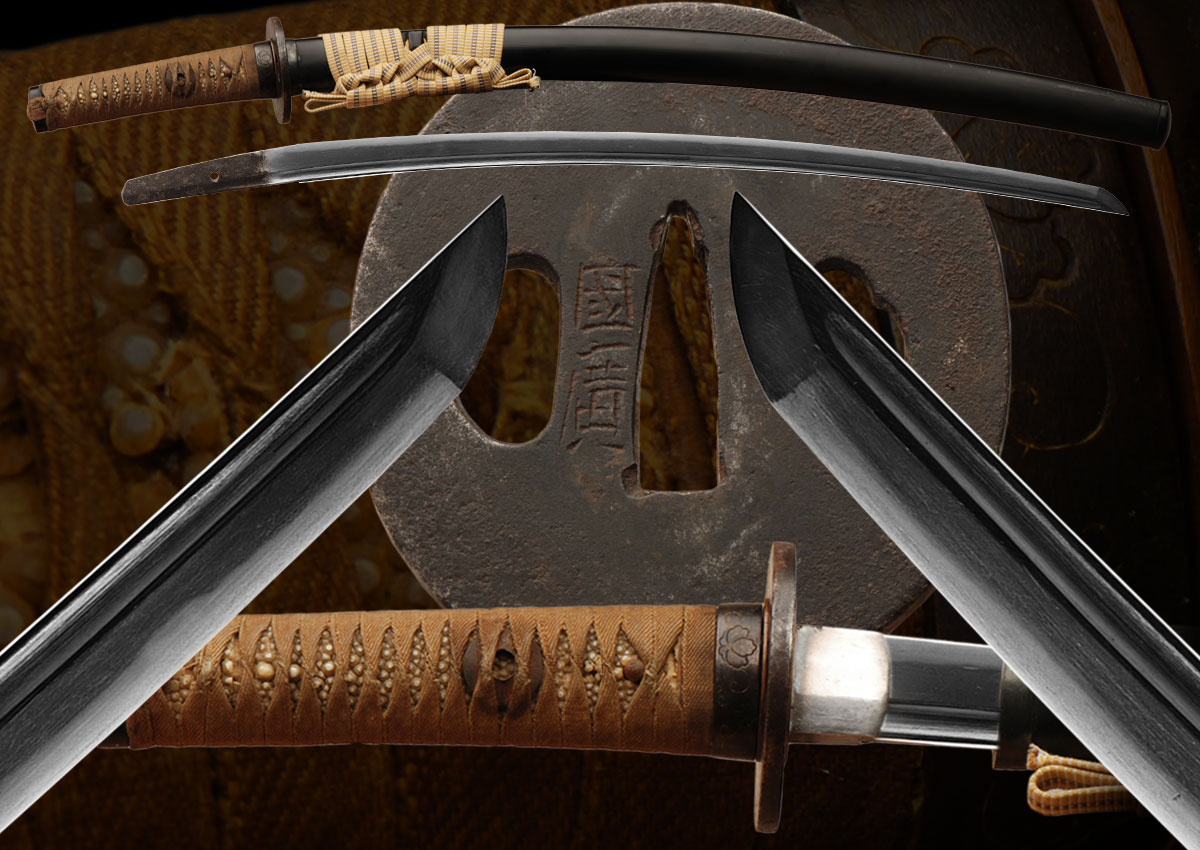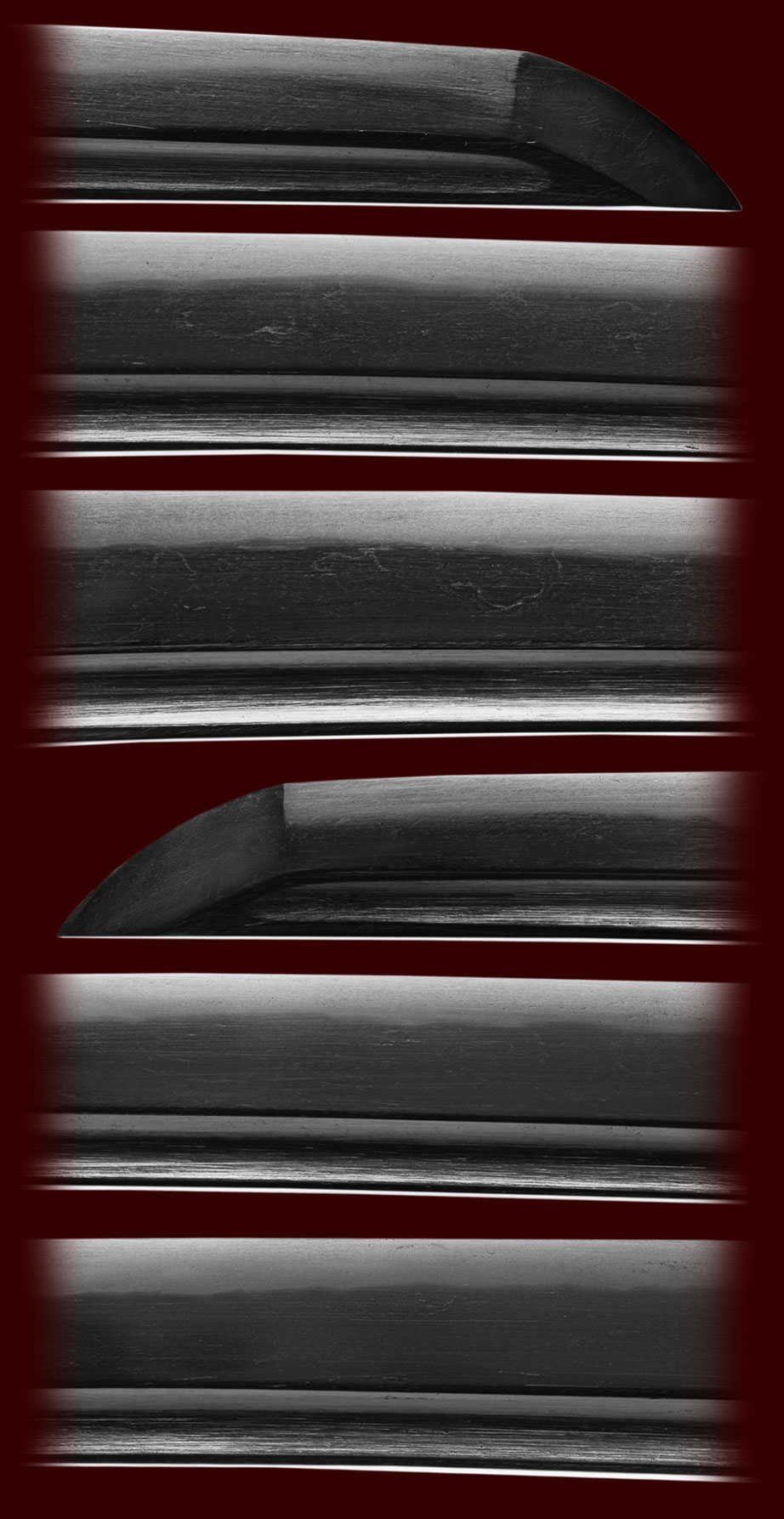FEATURED SWORD FROM THE SATSUMA REBELLION ERA !!
Up for sale is an originally mounted sword from the Satsuma rebellion era. This blade is a longish ubu wakazashi at 20 3/4″. this is a (1400’s-1500’s) koto Bizen sword with Bohi as Horimono. There is a beautiful curvature with much hataraki through out waiting to be exposed. The koshirae is an original set of Satsuma Rebellion era style mountings. The simplicity of the mounts are an understated testament to the last of the Samurai. There is a plain iron Tsuba with signature and a non descript pair of round pierced coin like menuki . The hada appears to be a fine itame/Mokume blend with a slight gunome midare in Sugu-ha hamon. A fantastic sword waiting to be polished. The restored saya is in a bit of a matte black lacquer finish with a pale yellow fluted sageo and blue accent running through the middle. The fuchi kashira are a floral motif in iron and horn all original to the sword. A great period piece from the Satsuma rebellion era mounted with an ancestral koto blade. TO NOTE: The blade reminds one of a ko-dachi in shape and form forged from that time period.
To reflect on the Satsuma Rebellion:
The first test of the young Meiji government came with the revolt of the powerful Satsuma clan based in the southern region of the island of Kyushu. This influential clan was headed by the Shimazu family, which had been founded by Shimazu Tadahisa, son of Minamoto Yoritomo, in the Kamakura period. It was one of the two powerful clans (the other was the Choshu) that made the restoration of power to the Emperor possible. After nine years of working close to the central government, the samurai of Satsuma had grown dissatisfied with the direction the government was taking. They organized a considerable army to fight against the untried troops of the central government. It was a momentous clash between traditional Japanese warfare, as waged by the sword-wielding individual warriors, and the new peasant army, trained in western strategy and using western weapons. The rebellion was led by Saigo Takamori, a giant of a man with an engaging personality who, just a few years earlier, had been a leader in the government and who, as field marshall, had actually been responsible for forming the government army that he now opposed. Saigo was one of the three young samurai who had joined the government and whose personal magnetism had helped to weld it together. The second was Kido Koin,a samurai from the Choshu clan, who was an extraordinarily able diplomat, a master of the art of persuasion. Kido’s historical importance rests primarily upon his conviction that feudalism had to be abolished if the nation was to prosper together with his ability to convince the feudal lords that it was in their own interests, as well as their patriotic duty, to return the Emperor to power and to support the new central government. The third of the triumvirate was Okubo Toshimichi who, as Saigo, was also a member of the Satsuma clan. Saigo was the impetuous man of action, Kido the diplomat, and Okubo the master planner of the new regime. Later it was because of the opposition of Okubo to Saigo ‘s ideas for conquest and expansion that Saigo resigned from the government. Saigo had advanced a plan for the conquest of Korea that included sending an envoy to that country to make impossible and insulting demands. This would result, he explained, in the Koreans executing the envoy and would thereby give Japan an excuse for declaring war. The envoy, he insisted, would be himself. Okubo and Kido refused him, and Saigo went back to his home in Kyushu. There, he was prevailed upon to join the rebellious samurai and to lead them against the government army. The government acted swiftly to crush the rebellion. The fighting was brief but bloody. Saigo and his men fought well, but the government soldiers easily triumphed. When he was badly wounded, he committed suicide in the samurai tradition, rather than be captured. But his contribution to the early government, his bravery and spirit were not forgotten. He became a hero to future Japanese soldiers and was pardoned posthumously by the Meiji Emperor, whom he had both supported and opposed.
ANOTHER INTERESTING PIECE:
THE ORGANIZATION OF THE IMPERIAL AND SATSUMA ARMIES: After the Restoration of 1868, one of the top priorities of the new Imperial government was the formation of a national army under its control. On October 2, 1870, one month after the French defeat at Sedan, the government announced that its army would be modeled after the French Army (the announcement also stated that the new navy would be modeled after that of Britain). One of the major considerations in choosing the French system over that of Prussia was that more Japanese military men spoke French than German.
By the time of the Satsuma Rebellion, the Imperial Japanese Army numbered over 34,000 men and consisted of both line and imperial guard troops. The line infantry was divided into 14 regiments of 3 battalions each. Each battalion consisted of 4 companies. In peace time, each company had approximately 160 privates and 32 officers and non-commissioned officers. During war time a company’s strength was to be increased to 240 privates. A battalion had 640 men in peace time and was supposed to have 960 men in war time.
There were two “regiments” of line cavalry and one “regiment” of imperial guard cavalry. The two line regiments each contained 120 men in peace time and were to be increased to 150 men each during war time. Contemporary illustrations show the cavalry armed with lances.
The Imperial Artillery consisted of 18 batteries divided into 9 battalions, with 120 men per battery during peace time. During war time, the mountain artillery was supposed to have 160 men per battery and the field artillery was supposed to have 130 men per battery.
Due to the suddenness of events in Satsuma, the line units of the Imperial Army seem to have taken the field at their peace time strength.
The Imperial Guard (most of whom were ex-samurai) was always maintained at war time strength. The guard infantry was divided into 2 regiments of 2 battalions each. A battalion was 672 men strong and was organized as per the line battalions. The cavalry regiment consisted of 150 men. The artillery battalion was divided into 2 batteries with 130 men per battery.
The Japanese Army did not have a brigade or corps system like the French or many other European armies. Japan was divided into six military districts: Tokyo (Yedo), Sendai, Nagoya, Osaka, Hiroshima and Kumamoto. There were usually two or three regiments of infantry, plus artillery and other auxiliary troops, assigned to each district. The Imperial guard was assigned to the Tokyo district.
The uniforms of the Japanese Imperial Army resembled those of the French Garde Mobile in appearance. Japanese infantrymen wore a dark blue kepi, a short jacket with French style field pack, and dark blue pants (in summer, the uniform was white). They were armed with breech-loading Snider rifles and could fire approximately six rounds per minute. The cavalry wore red kepis with a small white plume in the front, dark blue jackets, red pants with a yellow stripe, and black boots. At least one illustration shows their saddle blankets as being red with yellow trim and their lance pennants were red over white. Artillery consisted of over 100 artillery pieces, including 5.28 pound mountain guns, Krupp field guns of various calibers, and mortars.
In addition to the army, the central government also used marines and Tokyo policemen in its struggle against the Satsuma samurai. The police were primarily comprised of ex-samurai (many of whom were from Satsuma) and were armed only with wooden batons and swords (Japanese police did not carry firearms until the Rice Riots of 1918). The police were mobilized in units ranging from 300 to 600 men.
The Satsuma samurai army was initially organized into six battalions (or regiments) of 2,000 men each. Each battalion was divided into ten companies of 200 men, which were further divided into four platoons of 50 men. On its march to Kumamoto Castle, the army was divided into three divisions; an advance guard of 4,000 men, another division of 4,000 men, and a rearguard of 2,000 men. There were 200 artillerymen and 1,200 laborers in the army. In April 1877, Saigo reorganized the army into nine infantry units of 350 to 800 men each.
The samurai attempted to dress in a similar manner to give the appearance of uniformity. Their dress consisted of their own clothes and armor was not worn, except by a few officers who wore a breastplate. Saigo and some of his officers wore their military uniforms. Each samurai wore a white cloth on his upper arm so that they could identify themselves.
The samurai were armed with Enfield muzzle loading rifles and could fire approximately one round per minute. Their artillery consisted of 28 mountain guns, 2 field guns (15.84 pounders), and 30 assorted mortars.
When the students raided the Kagoshima armories a large number of sword blades were seized. Many of these blades were of inferior quality and were fitted with blackened iron hilts. The hilts were bound with rough braid or canvas. Some samurai who later joined the Satsuma army may have carried yaris (spears).
Although the Satsuma Army did not contain any cavalry, a few officers such as Saigo were mounted.
Copyright © by Robert W. Burke, Jr. May 21, 1991
- Mei: Mumei
- Date: Koto era (1400’s-1500’s)
- Nagasa: 20 3/4 inches
- Sori: 22.5 mm
- Width at the ha-machi: 25.6 mm
- Width at the yokote: 15.2 mm
- Thickness at the mune-machi: 4.2 mm
- Construction: Shinogi zukuri
- Mune: Iori
- Nakago: Ubu
- Kitae: Itame/mokume
- Hamon: Midare Gunome
- Boshi: Maru
- Condition: older polish
Email us if your interested in this item and remember to include the order number for this item: fss-668.
For Sale
